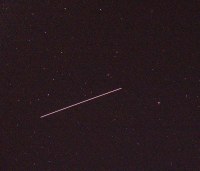
Patricia Carroll captured the ISS passing from Bootes to below Corona Borealis.
She used a digital camera. Taken from Glencree, Co Wicklow on 16 May 2004.
Barry Pickup captured the Russian Space Station Mir in its final days passing Saturn, Jupiter, the Hyades and the Moon.
He used a 25mm focal-length f/4 lens with Kodak Gold 400ASA, ~ 35 - 40 sec exposure. Taken from Dublin on 2001 March 3, 19:41 UT
The Space Station was sucessfully de-orbited on March 23rd 2001.
A magnitude -6 flare from the Iridium #47 satellite. Jupiter (magnitude -2.5) is towards the bottom, while the twins Castor and Pollux are just above the flare in cloud. Magnitude -6 is brighter than any of the planets can get. Apart from the flare these satellites are quite faint.
A 50mm focal-length lens was used at f/2. 2003 February 27, 19:49 UT. Photo by John O'Neill.